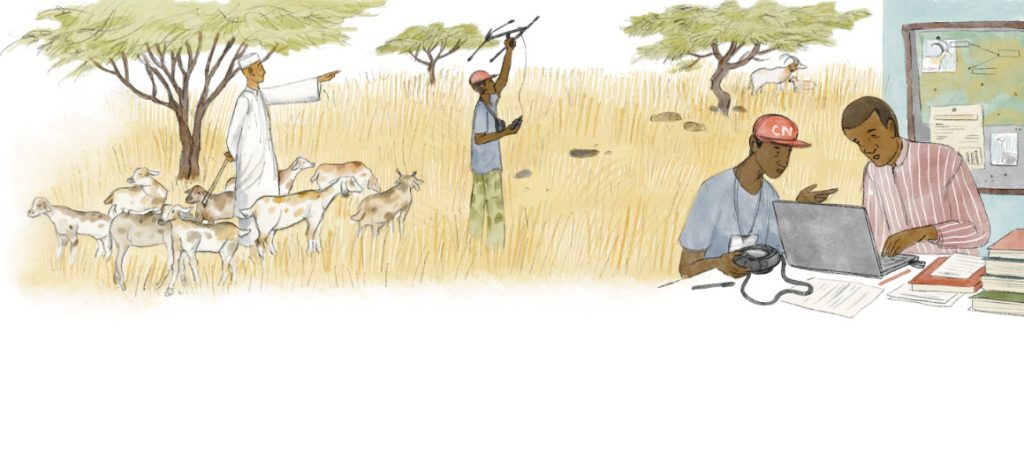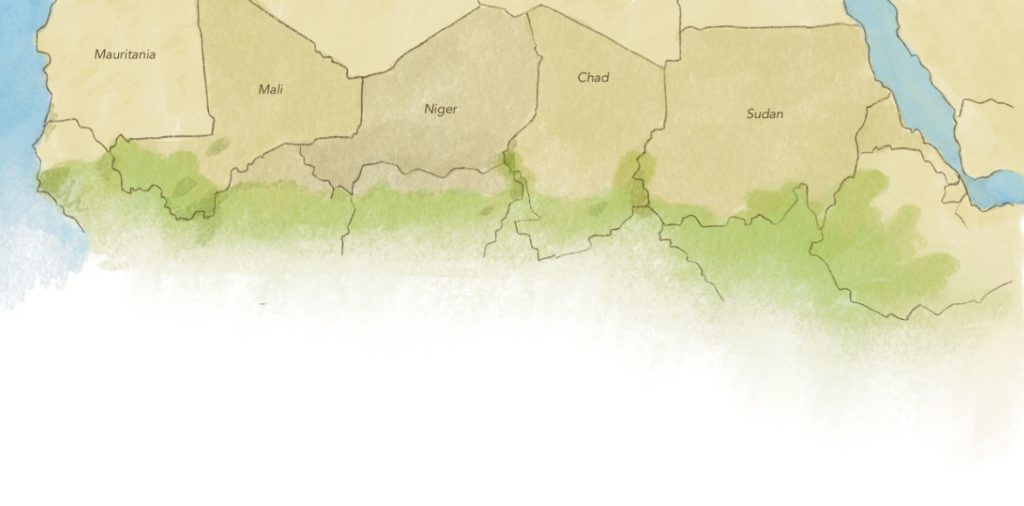The wildlife of the Sahara and bordering Sahelian grasslands are some of the most threatened on Earth. Drought, desertifcation, habitat loss and, above all, over hunting, have reduced many species to the verge of extinction. Animals such as the addax (Addax nasomaculatus), dama gazelle (Nanger dama), and cheetah (Acinonyx jubatus hecki) have disappeared from over 95 percent of the territories where they were found earlier. One of the region’s most iconic species, the scimitar-horned oryx (Oryx dammah), became extinct in the wild in the 1980s, and several others are severely threatened over large parts of their range. This includes species such as the Barbary sheep (Ammotragus lervia), dorcas gazelle (Gazella dorcas), slender-horned gazelle (Gazella leptoceros), Cuvier’s gazelle (Gazella cuvieri), striped hyena (Hyaena hyaena), ostrich (Struthio camelus camelus), and Nubian (Neotis nuba) and Arabian (Ardeotis arabs) bustards.
Over much of the Sahel and Sahara the fate of these unique species is being played out against a dramatic backdrop of climate change, unsustainable land use, political instability, and armed insurgency. Despite this daunting situation, efforts led by the Sahara Conservation Fund (SCF) over the past 20 years have achieved important milestones, including putting Saharan conservation more frmly on the global conservation map. Working with diverse partners in Chad and Niger, efforts are underway to save the remaining wild populations of addax, dama and dorcas gazelles, to restore the scimitar-horned oryx, and to reinforce populations of the almost extinct addax.

Unlike many endangered species today, the oryx’s disappearance was largely due to overhunting rather than habitat loss. Up until the early 1960s, the species was still relatively common over much of its Sahelian range, from Mali in the west, through Niger and Chad, and into Sudan. Always a target species for traditional hunters, using dogs and horses to hunt them, the impact on population size was probably quite low and highly seasonal. As pastoral development opened up the hitherto waterless and largely uninhabited grasslands used by the oryx, the impact of traditional hunting increased, as did the number of all-terrain vehicles and modern firearms.
With virtually no protection or law enforcement, oryx numbers rapidly plummeted and by the end of the 1970s the species was confned to a couple of populations in eastern Niger and central Chad. At that time, the wild population almost certainly numbered less than 5000 individuals, with most of these in the Ouadi Rimé-Ouadi Achim Game Reserve in central Chad. In 1979, civil war broke out in Chad, wiping out much of the larger desert wildlife in the Ouadi Rimé reserve and elsewhere. The last oryx was reportedly shot in Chad in the late 1980s. Fortunately, oryx held in captivity were quite numerous.
Today, although the oryx’s native grasslands of central Chad are impacted by serious overstocking of livestock, overgrazing and bushfres, wildlife still has access to large areas of suitable habitat. Recognising the opportunity and with encouraging support from regional governments, the Sahara Conservation Fund began collecting data to develop a plan to reintroduce the oryx from captive-bred sources into a suitable site. Meetings were held in 2010 and 2012 and the selected reintroduction site was the Ouadi Rimé-Ouadi Achim reserve in Chad—the oryx’s previous stronghold.
Following a feasibility study carried out in 2015, March 2016 marked a major milestone for regional conservation efforts. 25 oryx bred in captivity were fown from Abu Dhabi to Chad to seed one of the world’s most ambitious reintroduction programmes. From this founding population, 218 oryx have been reintroduced into the wild to date and by mid-2021 these had grown to a free-roaming population of around 380 animals. There have been setbacks, including deaths from disease, calf predation, and possibly malnutrition during hard times, but the overall trend continues to be very positive.

Bringing back the addax
In the neighbouring Sahara, the addax population has been following an inexorable downward decline for many decades. Today, the entire remaining wild population of a few dozen animals is confned to the Tin Toumma desert of eastern Niger. Two decades ago, the addax population had stabilized at around 300–400 animals. But with the discovery of oil in eastern Niger and the fall of the Ghaddaf regime across the border in Libya, new threats to their survival emerged in the form of massive disturbance from oil exploration, an infux of arms and four-wheel drive vehicles from Libya, and uncontrollable poaching by the armed forces sent to protect the oil workers.
The extinction of a species, either locally or globally, is not simply the loss of a unique plant or animal amongst many others but often the disappearance of a key element in a complex local web of life. For species like the addax, it is also the loss of innate and learned behaviour that, in addition to physical and morphological adaptations, permit the animals to survive and thrive in one of the world’s most hostile environments. Reintroduction may be able to bring back similar animals biologically, but it can never replace the intrinsic knowledge and culture of the animals that lived, learned, and evolved in that place over countless generations. Preventing, at all costs, the extinction of wild populations of animals, however small their numbers, is essential.
Encouraged by the results of the efforts to restore the scimitar-horned oryx, the Government of Chad, the Environment Agency of Abu Dhabi, and the Sahara Conservation Fund decided to include the addax as part of their reintroduction programme. In 2020, the frst addax were released into the wild and today they total over 50 animals. Plans are also underway to supplement populations of the critically endangered dama gazelle, a magnifcent Sahelian species now reduced to four tiny, isolated populations in Chad and Niger. In association with African Parks Network, ostriches from southern Chad are also being reintroduced into the Ouadi Rimé and Ennedi reserves.

The need for long-term conservation
While the reintroduction of the scimitar-horned oryx, and more recently the addax, has posed a host of logistical challenges, the longer-term conservation of these species will depend on the successful management of the large arid landscapes in which they reside. Much has changed across the grasslands of the Sahel since the 1990s. Land that was largely unoccupied for most of the year is now dominated by livestock and the consequent impacts of competition for natural wet season waterholes, overgrazing and loss of preferred plant species, disturbance, bushfres, and the spread of cattle-borne diseases. In Chad, at least, hunting is under control for now, but could become a major problem should insecurity and civil unrest occur. Human activities apart, there is also the impact of habitat loss through long-term climate change and desertifcation. Coming to terms with this new paradigm is far more challenging than simply
controlling poaching.
Created in 1969, the Réserve de faune de Ouadi Rimé-Ouadi Achim allows the pursuit of traditional forms of resource use, including grazing, use of dead wood, and access to natural waterholes and wells. What this arrangement failed to recognize was the vast increase in the numbers of people, livestock, and wells. Other rules and regulations are also completely out of date, necessitating a major overhaul of the reserve’s decree and limits, not only to bring it up to date, but also to permit management of space and natural resources for the long-term beneft of both humans and wildlife.
While most of the local people in and around the vast Ouadi Rimé-Ouadi Achim reserve are genuinely happy to see the return of the iconic and truly impressive addax and oryx, they currently have no real vested interest in their long-term conservation. Direct benefts are few and indirect ones—such as improved rangeland management, bushfre control, and the potential of future tourism development—are largely intangible. In the long term, improved rangeland management and the restoration of currently degraded grazing resources could be strong incentives.
To achieve long-lasting results in the social and environmental context of a largely mobile pastoral society requires not only working at a larger scale—the Ouadi Rimé-Ouadi Achim reserve is twice the size of Belgium—but also in a way that truly incorporates social needs and priorities with those of conservation. The two are not incompatible, but even if they were, the realities of today dictate the pursuit of cooperation and cohabitation. Exclusion of the human element from landscapes so critical to the survival of people with virtually no viable alternatives is neither just nor practical. The promising growth in delegated management and private-public partnerships over the past decade is highlighting what can be achieved using new models of protected area administration. Thanks to support from the European Union, an experiment in management of the Ouadi Rimé-Ouadi Achim reserve with full participation from the local population is underway. The development of an effective and sustainable conservation model in the region will hopefully emerge, beneftting the interests of both people and wildlife while providing a valuable example to other protected areas in the Sahara and the Sahel.






